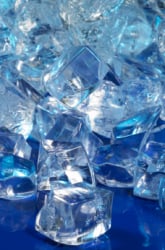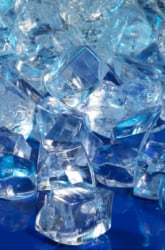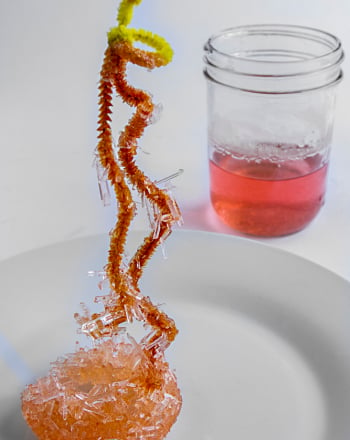Science project
Can Crystals Show Color Mixing?
Type
Grade Level
Elementary (grades 2 through 4)
Difficulty of Project
Cost
$12.00 excluding the cost of the Tri-fold cardboard display board
Safety Issues
Investigator should not ingest the crystals or drink the liquids associated with the activity. The crystals used in the project are extremely slippery when spilled. Never flush or pour these crystals down the drain, crystal swelling could possibly clog drainpipes. Also handling food dyes can stain both hands and clothing it is advisable that the young investigator wear gloves and an apron.
The supervising adult should discuss the warnings and safety information with the child or children before commencing the activity.
Material Availability
The materials required for this project are readily available and inexpensive.
Approximate Time Required to Complete the Project
Two hours
Objective
Hydrogel superabsorbent polymer crystals are able to soak up as much as 500 times their weight in water! The research aspect of this science fair project is to determine if these crystals will absorb food dye and when the different colored crystals are placed in contact with each other, will the colors mix by the process of diffusion.
This science fair project focuses on a special kind of polymer called a hydrogel superabsorbent crystal which absorbs water, swelling to many times its original size. This water absorption ability will be used to determine if these crystals can be used to show color mixing by the process of diffusion. The investigator will place hydrogel crystals containing different colored dyes into a slender tube or bottle and observe if there are changes in color as the dyes mix via the process of diffusion. From the observations made a data table will be generated based on the results of the investigation.
Materials and Equipment / Ingredients
Hydrogel superabsorbent crystals, plastic cups, food coloring, Sieve, 4 to 8 sections of a plastic fluorescent tube casing, or tall-slender empty plastic container, disposable gloves, and an apron.
With the possible exception of the crystals, all the other items can be purchased from the local supermarket, hardware, homebuilding or garden supply store. Also, a Tri-fold cardboard display board can be purchased from an art & crafts supply store.
Introduction
Diffusion is the process in which there is movement of a substance from an area of high concentration of that substance to an area of lower concentration.
As the young investigator will discover layering blue, yellow, and red will produce orange and green which will seem to appear out of nowhere! If the investigator obtains the three primary colors of blue, red, and yellow he/she can mix any shades of color listed on the color wheel.


Food coloring purchased from the grocery stores typically comes in the three colors of blue, red, yellow along with green. By definition, the primary colors are the main colors that the investigator can combine in some prescribed amounts to arrive at any other color.
To achieve other colors, check out the tips written on the food coloring package label. Mixing equal parts of any two primary colors produces the secondary colors of green, orange, and violet. For example, one drop of red mixed with one drop of yellow will create orange; one drop yellow plus one drop of blue makes green; and one drop blue plus one drop of red makes violet.
Digital photos can be taken during the experimenting process and/or images of hydrogel crystals can be downloaded from the Science in a Bag website for free and without copyright infringement issues. Images of a color wheel to place on the Tri-fold cardboard display board can be downloaded from the Internet.
Research Questions
- What are hydrogel crystals?
- What are the primary colors?
- What did you see when the different colored crystals touched each other? Why do you think this happened?
- How many different colors did you produce? How did the crystals feel?
- What color appeared when the following colored crystals were mixed: Red and yellow? Blue and yellow? Red and blue?
- How could you make purple, orange, or green?
Important Terms and Concepts
Primary color, secondary colors, hydrogel crystal, diffusion, and color wheel
Experimental Procedure
- Setup three cups. Fill each cup half full of water. Add a few drops of blue coloring to the first cup, yellow to the second cup, and red food coloring to the third and stir.
- Add hydrogel crystals to each cup and let stand 20 minutes or until they cannot be clearly seen in the colored water.
- Sieve the mixtures. It is best to do this over a large container rather than the sink in case some of crystals spill out of the sieve.
- Combine several of different colors (in layers) in a tall slender empty water bottle or make a huge rainbow wand using a plastic fluorescent tube casing and watch the colors melt into each other. Record the color combinations in a table similar to the one shown below.
- Repeat the same procedure mixing different color combinations
- To reuse the crystals, lay them on a paper towel and let dry over a few days. They may stain beneath the towel, so add a layer of aluminum foils.
|
Individual Crystal Color Additions |
Combined Crystal Color
|
||
|
Red |
Blue
|
Yellow
|
|
|
|
|
|
|
|
|
|
|
|
|
|
|
|
|
Title: Growing Crystals, Author: Ann O Squire, Publisher: Children's Press, ISBN-10: 0516269844 and ISBN-13: 978-0516269849
This paperback book describes how to grow crystals. It is ideal for today's young investigative reader this book includes lively sidebars, a glossary and index, plus a comprehensive “To Find Out More” section listing books, organizations, and Internet sites.
This book provides a basic color palette for each art medium, demonstrating an array of color mixes, as well as offering full explanations of various paints and pigments. This invaluable guide features scores of tips and techniques for color mixing with oils, acrylics, watercolors, inks, pastels, food coloring, and virtually every other art medium. It also includes in-depth information on how to determine the opacity and strength of a color, and hundreds of color illustrations make everything simple. The material in the book is comprehensive, adult-level in scope and sequence however; the young investigator and his or her parents (teachers) can use this book as a general reference resource.
- Hydro-gel Crystal Experiments
- Tips on Mixing Liquid Food Coloring
- Diffusion and Osmosis
- How to make a Crystal Appear and Disappear?
- Color Wheel
Note: The Internet is dynamic; websites cited are subject to change without warning or notice!
Education.com provides the Science Fair Project Ideas for informational purposes only. Education.com does not make any guarantee or representation regarding the Science Fair Project Ideas and is not responsible or liable for any loss or damage, directly or indirectly, caused by your use of such information. By accessing the Science Fair Project Ideas, you waive and renounce any claims against Education.com that arise thereof. In addition, your access to Education.com's website and Science Fair Project Ideas is covered by Education.com's Privacy Policy and site Terms of Use, which include limitations on Education.com's liability.
Warning is hereby given that not all Project Ideas are appropriate for all individuals or in all circumstances. Implementation of any Science Project Idea should be undertaken only in appropriate settings and with appropriate parental or other supervision. Reading and following the safety precautions of all materials used in a project is the sole responsibility of each individual. For further information, consult your state's handbook of Science Safety.













